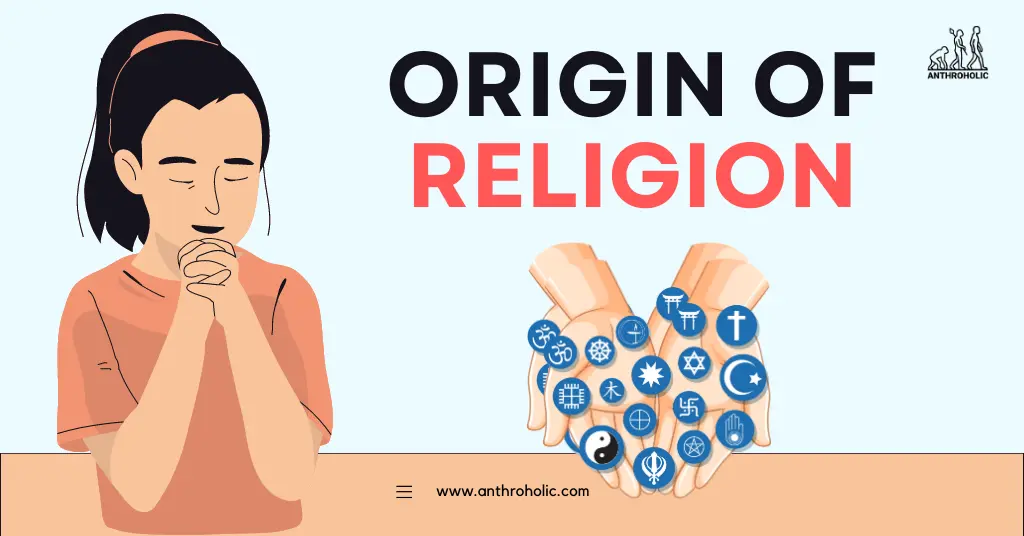AI Answer Evaluation Platform Live Now. Try Free Answer Evaluation Now
Origin of Religion
Religion, an integral part of human culture, has always been a subject of great fascination for anthropologists. Our interest here lies in exploring its origins, answering questions such as: when did religion emerge in the human experience? How did it come about, and why?

Early Signs of Religion
Archaeological Evidence
Archaeologists have found early signs of religious beliefs in the remains of our ancient ancestors, pointing to the existence of religion even before the advent of civilization. Paleolithic cave paintings, such as those in Lascaux and Chauvet in France, dating back approximately 30,000 years, contain symbols and images which are believed to represent religious or spiritual ideas [1]. Other archaeological indicators include grave goods, the deliberate burial of the dead with items assumed to be useful in the afterlife, a practice that began around 100,000 years ago [2].
Evolution of Religion
From these humble beginnings, religion has evolved significantly. Early religion was primarily animistic or totemistic, as our ancestors sought explanations for the world around them. As societies grew more complex, so did their religious systems, eventually leading to the polytheistic and monotheistic religions of today [3].
Animism and Totemism
- Animism: Early humans believed that all objects, animate and inanimate, possessed a spirit. This belief is considered one of the earliest forms of religion [4].
- Totemism: Totemism is an early religion associated with tribal societies in which each group or clan has a totem, or a symbolic representation, often an animal or plant, with which they identify [5].
Polytheism and Monotheism
- Polytheism: With the rise of civilization, particularly in Egypt and Mesopotamia, polytheism, the belief in multiple gods, emerged. Each god was often responsible for a specific aspect of life or nature.
- Monotheism: Monotheism, belief in one god, emerged later. Some of the first monotheistic religions include Zoroastrianism, Judaism, and eventually, Christianity and Islam.
Theories of Religion’s Origin
Several theories propose different reasons for the emergence of religion in human societies.
Intellectual Theories
Intellectual theories, such as those proposed by Edward Burnett Tylor and James Frazer, argue that religion originated as early humans tried to explain natural phenomena. They began by attributing human-like characteristics to these phenomena (animism), then created gods to control them (polytheism), and finally arrived at monotheism.
Psychological Theories
Psychological theories, like those presented by Sigmund Freud, suggest that religion was born out of psychological needs. For instance, the need for a father figure led to the creation of a god or gods. Moreover, religion provided answers to fears of mortality and the unknown.
Sociological Theories
Emile Durkheim and other sociologists propose that religion arose as a way to promote social cohesion and order. It provided a moral code and set of norms, fostering a sense of community and shared values among its followers.
Evolutionary Theories
Recently, evolutionary anthropologists have suggested that religious belief could be an evolutionary adaptation. It may have provided a survival advantage by promoting group cooperation and cohesion, thus improving the group’s chance of survival.
| Theory Type | Key Proponents | Basic Idea |
|---|---|---|
| Intellectual | E.B. Tylor, J. Frazer | Religion as a means to explain natural phenomena |
| Psychological | S. Freud | Religion born out of psychological needs |
| Sociological | E. Durkheim | Religion promoting social cohesion and order |
| Evolutionary | D. Wilson, R. Sosis | Religion as an evolutionary adaptation |
Conclusion
Religion is as old as humanity itself. While its exact origins remain elusive, various theories provide valuable insights into why and how religion might have arisen. It’s an intriguing blend of early humans’ attempt to understand their environment, fulfill psychological needs, maintain social cohesion, and potentially even survive.
References
[1] Lewis-Williams, D. (2002). The Mind in the Cave: Consciousness and the Origins of Art. Thames & Hudson.
[2] Pettitt, P. (2002). The Neanderthal dead: exploring mortuary variability in Middle Palaeolithic Eurasia. Before Farming, 1(4).
[3] Boyer, P. (2001). Religion Explained. Basic Books.
[4] Tylor, E.B. (1871). Primitive Culture. John Murray.
[5] Durkheim, E. (1912). The Elementary Forms of Religious Life. George Allen & Unwin.




